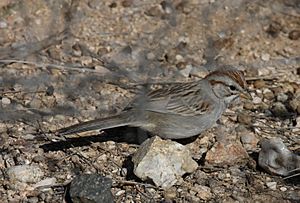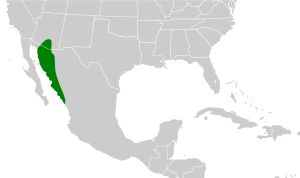Rufous-winged sparrow facts for kids
Quick facts for kids Rufous-winged sparrow |
|
|---|---|
 |
|
| Conservation status | |
| Scientific classification | |
| Genus: |
Peucaea
|
| Species: |
carpalis
|
| Subspecies | |
|
Peucaea carpalis carpalis |
|
 |
|
| Synonyms | |
|
Aimophila carpalis |
|
The rufous-winged sparrow (Peucaea carpalis) is a small bird. It has a long tail. Its face is gray, and its head and eyebrows are rusty red. The rusty parts of its wings, which give it its name, are often hidden.
Contents
What Does It Look Like?
The back of this sparrow is brown with darker stripes. Its belly is a light gray color. The wings and the top of its head are a rust color. This bird has a cone-shaped beak that is yellow at the bottom. It also has a long, brown tail.
Where Does It Live?
The rufous-winged sparrow lives all year in certain areas. You can find it from south-central Arizona and Guadalupe Canyon, New Mexico. Its home range goes south into northern Sinaloa, Mexico.
This sparrow likes to live in desert grasslands. These areas often have scattered mesquite trees or cholla cacti. It also lives near washes. These are dry riverbeds that sometimes fill with water. They have sandy bottoms and green slopes. You might also see them in brushy irrigation ditches. They also live near creeks with broad-leaved trees, mesquite, grasses, and forbs (small flowering plants).
What Does It Eat?
During the time when they have babies, adult rufous-winged sparrows eat many different insects. They can catch insects while flying. They also pick them off plants. At other times of the year, these birds mostly eat seeds.
Family Life: Raising Young
Rufous-winged sparrows usually have their babies during the monsoon season. This is in July and August. They build their nests low to the ground. They choose small trees, bushes, or cacti. Some common plants they use are hackberry, palo verde, cholla, and mesquite.
A female sparrow usually lays about four eggs. A pair of sparrows might have two groups of babies each year.
Is It Safe?
This bird is listed as a migratory bird. This means it is protected under the Migratory Bird Treaty Act. This law helps protect birds that travel between countries.
A Look Back: Sparrows in Arizona
The rufous-winged sparrow has a history in Pima County. Charles Emil Bendire first found this bird there in 1872. He found them near old Fort Lowell in Tucson. At that time, they were quite common.
By 1881, there were fewer sparrows around Tucson and Camp Lowell. They liked to hide in thick mesquite bushes. They also hid in bunches of 'sacaton' grass. If startled, they would fly up into the branches above.
By the late 1880s, these sparrows might have disappeared from Arizona. This was possibly because too many animals were eating the plants. The sparrows started to come back to the United States around 1936. Now, you can find them in good habitats. These areas include much of eastern Pima County, Santa Cruz County, and western Cochise County. Losing their homes due to too much grazing and city growth has been a big problem for them.
See also
 In Spanish: Chingolo alirrufo para niños
In Spanish: Chingolo alirrufo para niños


